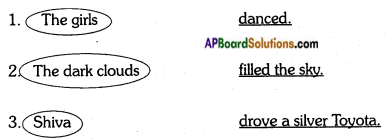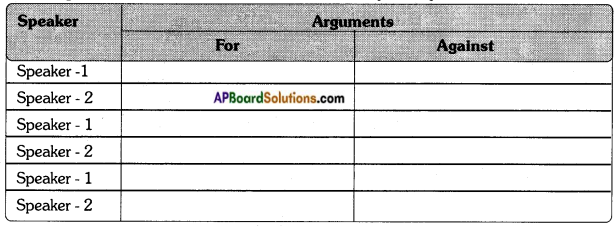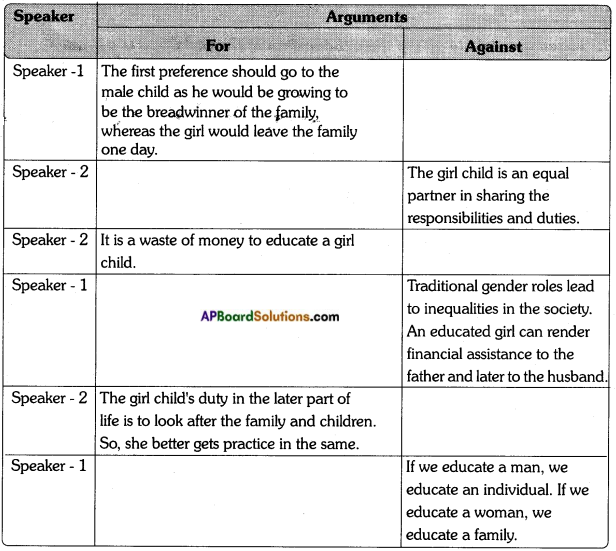 |
| AP Board Class 8 English Bonsai Life Part 2 Textbook Solutions PDF: Download Andhra Pradesh Board STD 8th English Bonsai Life Part 2 Book Answers |
Andhra Pradesh Board Class 8th English Bonsai Life Part 2 Textbooks Solutions PDF
Andhra Pradesh State Board STD 8th English Bonsai Life Part 2 Books Solutions with Answers are prepared and published by the Andhra Pradesh Board Publishers. It is an autonomous organization to advise and assist qualitative improvements in school education. If you are in search of AP Board Class 8th English Bonsai Life Part 2 Books Answers Solutions, then you are in the right place. Here is a complete hub of Andhra Pradesh State Board Class 8th English Bonsai Life Part 2 solutions that are available here for free PDF downloads to help students for their adequate preparation. You can find all the subjects of Andhra Pradesh Board STD 8th English Bonsai Life Part 2 Textbooks. These Andhra Pradesh State Board Class 8th English Bonsai Life Part 2 Textbooks Solutions English PDF will be helpful for effective education, and a maximum number of questions in exams are chosen from Andhra Pradesh Board.Andhra Pradesh State Board Class 8th English Bonsai Life Part 2 Books Solutions
| Board | AP Board |
| Materials | Textbook Solutions/Guide |
| Format | DOC/PDF |
| Class | 8th |
| Subject | English |
| Chapters | English Bonsai Life Part 2 |
| Provider | Hsslive |
How to download Andhra Pradesh Board Class 8th English Bonsai Life Part 2 Textbook Solutions Answers PDF Online?
- Visit our website - Hsslive
- Click on the Andhra Pradesh Board Class 8th English Bonsai Life Part 2 Answers.
- Look for your Andhra Pradesh Board STD 8th English Bonsai Life Part 2 Textbooks PDF.
- Now download or read the Andhra Pradesh Board Class 8th English Bonsai Life Part 2 Textbook Solutions for PDF Free.
AP Board Class 8th English Bonsai Life Part 2 Textbooks Solutions with Answer PDF Download
Find below the list of all AP Board Class 8th English Bonsai Life Part 2 Textbook Solutions for PDF’s for you to download and prepare for the upcoming exams:8th Class English Chapter 5B Bonsai Life Part 2 Textbook Questions and Answers
I. Complete the statements giving more than one reason.
1. Girls should be educated like boys because
a. ———————
b. ———————
c. ———————
d. ———————
Answer:
a. they need to stand on their own feet.
b. they need to get financial independence,
c. they need not to beg others for anything,
d. they need to lead a dignified life.
2. Fully grown trees are more useful because
a. ———————
b. ———————
c. ———————
Answer:
a. they give us shade.
b. they give us flowers and fruit.
c. they give us wood for constructions and firewood.
d. they give us medicines.
II. Answer the following questions:
Question 1.
Why was Akkayya perplexed?
Answer:
Akkayya was surprised to see the turayi and pomegranate trees in the little flower pots among the other flower plants. She didn’t know they were bonsai trees. So, she asked Ammalu why they planted those trees in the flower pots and how they could grow if they didn’t let them grow freely. Hearing Akkayya’s words, Ammalu burst into laughter. Akkayya didn’t understand why Ammalu had laughed. So, she was perplexed.
Question 2.
How is a bonsai reared?
Answer:
Bonsai is a Japanese art form using miniature trees grown in containers. A bonsai is created beginning with a specimen of source material. The source specimen is shaped to be relatively small. Then it is planted in a display pot. The practice of bonsai development incorporates a number of techniques, they are:
a) leaf trimming
b) punning the trunk, branches and roots
c) wining branches and trunks
d) clamping
e) grafting new growing material and
f) defoliation.
Question 3.
What similarities do you notice between the bonsai tree and the housewife?
Answer:
Like the housewife, the bonsai tree is very delicate. Both the housewife and the bonsai can’t protect themselves. They can’t provide shelter to anyone. They can’t bear sufferings. They depend upon others for everything.
Question 4.
What made the narrator feel the urge to free the bonsai?
Answer:
The narrator’s heart was touched by Akkayya’s words. Akkayya’s words made the narrator feel the urge to free the Bonsai. She thought that it was just as one freed a bird from a cage to let it fly.
Question 5.
What is the central theme of ‘Bonsai Life’?
Answer:
The central theme of ‘Bonsai Life’ is that the women should be well educated and empowered. The women should know how to take care of themselves. They should protect themselves. They should be able to stand on their own feet. They shouldn’t depend upon others for everything. They should take up jobs.
III. Make a list of activities done by a homemaker and a working woman.
| Homemaker | Working Woman |
Answer:
| Homemaker | Working Woman |
| 1) Serving the husband | 1) Doing the job |
| 2) Looking after the offspring | 2) Looking after the offspring |
| 3) Washing the clothes | 3) Managing the things at home |
| 4) Cleaning the floor | 4) Marketing |
| 5) Cleaning the vessels | 5) Cooking (in some cases) |
| 6) Cooking the dishes | 6) Washing (in some cases) |
IV. Put a tick (✓) mark against the most appropriate meaning for the phrases given below.
1. ‘… to keep the washerman’s account’ means
a) to take care of household work.
b) to count clothes,
c) to maintain the washerman’s account.
2. ‘… uphill task’ means
a) high quality work.
b) a difficult job.
c) working on a hill.
3. ‘… grass is greener on the other side’ means
a) the grass on this side is green.
b) others are as good as we are.
c) others are in a better position than us.
4. ‘… like a scorpion under a slipper’ means
a) killing a scorpion with a slipper.
b) being guided and controlled,
c) feeling totally suppressed.
Answer:
1 – a (✓)
2 – b (✓)
3 – c (✓)
4 – c (✓)
Vocabulary
I. Look at the phrasal verb underlined in the following sentence.
“I feel like giving it up. (give up).
What does it mean?
‘Give’ is a verb and ‘up’ is a preposition. Such combinations are called phrasal verbs. A phrasal verb normally gives a meaning different from the meaning of its parts.
‘Give up’ means ‘to stop doing something’.
Refer to a dictionary and find out the meaning of some more phrasal verbs beginning with ‘give’ and ‘look’.
give in ———–
give out ———–
give away ———–
look after ———–
look up ———–
look into ———–
Use the above phrasal verbs in your own sentences.
1. ———————–
2. ———————–
3. ———————–
4. ———————–
5. ———————–
6. ———————–
Answer:
give in: to accept that you are defeated
give out: to come to an end
give away: to give something to someone
look after: to take care of someone
look up: to become better
look into: to try to find out the truth about a problem.
1. The enemies were eventually forced to give in.
2. Her patience finally gave out.
3. I gave most of my books away to my friend.
4. The old man was looking after the child.
5. Finally, the things are beginning to look up.
6. The police officer is looking into the missing of the boy.
II. Look at the simile in the following sentence.
Without it, she will have to live under her husband’s thumb ‘like a scorpion under a slipper’. The life of a homemaker is compared to a scorpion under a slipper. When we compare two things, we often use the word ‘like’.
Here are a few more examples of similes.
1. He roars like a lion.
2. They eat like wolves.
Answer:
Look at the following similes.
a) bright like a full moon
b) sleep like a log
c) eat like a bird
d) beautiful like a rose
e) sweet like honey
Now write five sentences using the above similes.
1. ———————–
2. ———————–
3. ———————–
4. ———————–
5. ———————–
Answer:
1. This light is bright like a full moon.
2. He sleeps like a log.
3. She eats like a bird.
4. It seems beautiful like a rose.
5. It is sweet like honey.
III. Make some idioms from the words in circles and use them in your own sentences, one is done for you

Answer:
| Idiom | Sentence |
| thorn in flesh | He has been a thorn in flesh for them for years. |
| sore on back foot | Mr. Rao has been annoying them like a sore on back foot. |
| top of the world | As Sharma got a job. he is on top of the world. |
| cat on the wall | sriram has not yet decided; he is being like a cat on wall. |
Grammar
I. Read the sentences.
1.  grew accustomed to village life.
grew accustomed to village life.
2.  went into the kitchen.
went into the kitchen.
The words in circles are subjects. The words underlined are predicates.
II. Circle the subjects and underline the predicates.
1. The girls danced.
2. The dark clouds filled the sky.
3. Shiva drove a silver Toyota.
Answer:
III. Identify subjects and predicates in each of the sentence in the following paragraph.
The narrator felt very happy to receive her sister and brother-in-law, who came to stay with them. They brought many things with them. Akkaya made special dishes for her sister’s husband, which he liked very much. She praised her sister for being employed and making her living. She was very sorry about her position at home.
One day the narrator showed her Bonsai plants and explained how they are grown but she did not like it. On a rainy day many people gathered under a tree to take shelter. Showing this, Akkaya made the narrator understand the importance of freedom in one’s life.
Note: Subjects are given in bold letters and predicates are underlined.
i) The narrator – subject
felt very happy to recieve her sister and brother-in-law, who came to stay with them – predicate
ii) They – subject
brought many things with them – predicate
iii) Akkayya – subject
made special dishes for her sister’s husband which he liked very much – predicate
iv) She – subject
praised her sister for being employed and making her living – predicate
v) She – subject
was very sorry about her position at home – predicate
vi) the narrator – subject
showed her Bonsai plants and explained how they are grown but she did not like it – one day – predicate
vii) many people – subject
gathered under a tree to take shelter on a rainy day – predicate
viii) Akkayya – subject
Showing this – made the narrator understand the importance of freedom in one’s life – predicate
Writing
Look at the following poster.
List the features of this poster.
e.g. Who has issued the poster? What is it about?
The date, time, place of the event, layout and nature of the sentences.
Answer:
- Issuing authority: APDWACRA, Arunodaya building, Brodiepet, Guntur.
- Event: Inauguration of handicrafts exhibition cum sale.
- Time: 4 p.m.
- Date: 15 October
- Place: Gunta Ground, Kothapet, Guntur.
- Duration: From 15th to 25th October.
- Layout: Suitable layout with the sentences which convey the theme directly.
I. Now, make a poster based on the information given below.
- Issuing authority: Andhra Pradesh Arts and Crafts Society, Vijayawada.
- Event: Dance Performance by Aarthi.
- November 14.
- Chief Guest: Honourable Chief Minister of Andhra Pradesh.
- Venue: PWD Grounds, Vijayawada.
Answer:
Listening
I. Listen to a debate on the topic ‘Education of the Girl Child is a Burden’.
Education of the Girl Child Is a Burden
Speaker 1: Respected Chairperson, honourable Judges and dear friends, I stand here to express my views for the motion, ‘Education of the girl child is a burden’. I would like to state that the education of the girl child is indeed a burden. In a poor family the main concern for the head of the family is to provide food, clothing and health to all the members. Most of their resources are used for these priorities. Later, when they think of education, the first preference goes to the male child as he would be growing to be the breadwinner of the family, whereas the girl would leave the family one day. So, I feel that educating of the girl child is a burden.
Speaker 2: Respected chairperson, honourable Judges and dear friends! My knowledgeable opponent is of the opinion that the education of the girl child is a burden. May I ask how education of the girl could be a burden when she is an equal partner in sharing the responsibilities and duties? If given a chance, she will be sharing the burden of the family at least till she gets married. So, I strongly oppose the motion.
Speaker 1: When my opponent feels that the girl child would leave the family one day after marriage, can’t we agree that it is a waste of money to educate a girl child? Instead, the families can save the money to bear the expenses of her wedding. Yes, surely the girl can reduce the burden not by earning after education but by managing the household work. As her duty in the later part of life is to look after the family and children, she better gets practice in the same. If she is away from home for longer periods, it would be an additional burden on the family.
Speaker 2: My friend said, the future of the girl child is to look after the family and children. Haven’t such traditional gender roles led to inequalities in the society? I strongly feel that an educated girl can render financial assistance to the father and later to the husband. My dear friend, it is education that will bring about a change in the attitude of people towards the role of women. Indeed, it is rightly said: ‘If you educate a man, you educate an individual. If you educate a woman, you educate a family’.
Now, complete the table based on the information you’ve just listened to:
Answer:
Bonsai Life Part 2 Summary in English
Though Akkayya had been very interested in studying, Nannagaru didn’t educate her. He believed that studies wouldn’t get into a girl’s head. So, he had made Akkayya discontinue her education. He concentrated only on Annayya’s education. Akkayya got married to a villager and she was limited to do her household work. Ammalu took her Akkayya around the house. Akkayya was surprised to see the turayi and pomegranate trees in the flower pots among the flower plants. She felt sorry for them. She questioned Ammalu how they would grow in that little space and why they couldn’t let them grow freely. Ammalu explained that they were bonsai trees. She told that Bonsai was a special method of growing plants. The Japanese named this method bonsai. But Akkayya didn’t like this idea. Ammalu was distressed as she was unable to impress her Akkayya with her bonsai. Then came the storm which brought all the sand from the desert. Ammalu caught hold of Akkayya’s shoulder and dragged her into the room. After a while it started raining. Ammalu immediately pulled the bonsai tree pots and flower pots inside, under the canopy. Akkayya opened the window and looked at the streets. She saw many people standing under the huge turayi tree. She showed it to Ammalu saying that it was providing shelter to the people and potecting them. Ammalu asked her Akkayya what was the surprising thing about it. Then Akkayya made Ammalu understand that a housewife’s life was like that of a bonsai. Though bonsai looked proper and sweet, it was very delicate. It couldn’t provide protection to anyone. Infact, it had to be brought under the canopy so that it would not be destroyed. Akkayya’s words touched Ammalu’s heart. She felt like freeing the bonsai trees from their flower pots. Thus the story is a plea to provide education for women to empower them and make financially independent.
About the Author
Abburi Chayadevi is a well known feminist writer born in 1933. She has written many short stories and essays. She was awarded by the Central Sahitya Akademi in 2005. In her works, she elucidates women life and their feelings.
Bonsai Life Part 2 Glossary
adept (adj): a natural ability to do something skilfully
drudgery (n): hard, boring work
stunted (v): prevented from growth
perplex (v): confuse
canopy (n): a cover fixed over something for shelter
squall (n): a strong wind
rage (v): come with force
respite (n): a short period of rest
nought (n): nothing’zero
backyard (n): an area with a hard surface behind a house
trimming (n): making something neater, smaller, better by cutting parts from it
confine (v): to keep something inside the limits of a particular activity
disheartened (adj): made somebody lose hope or confidence
collapsed (v): lay down
tend (v): to care for something
withstand (v): to be strong enough not to be hurt or damaged by extreme conditions
dragged (v): pulled somebody or something along with effort and difficulty
AP Board Textbook Solutions PDF for Class 8th English
- AP Board Class 8 Textbook Solutions PDF
- AP Board Class 8 English Textbook Solutions PDF
- AP Board Class 8 English The Tattered Blanket Textbook Solutions PDF
- AP Board Class 8 English My Mother Poem Textbook Solutions PDF
- AP Board Class 8 English A Letter to a Friend Textbook Solutions PDF
- AP Board Class 8 English Oliver Asks for More Textbook Solutions PDF
- AP Board Class 8 English The Cry of Children Poem Textbook Solutions PDF
- AP Board Class 8 English Reaching the Unreached Textbook Solutions PDF
- AP Board Class 8 English The Selfish Giant Part 1 One-act Play Textbook Solutions PDF
- AP Board Class 8 English The Selfish Giant Part 2 One-act Play Textbook Solutions PDF
- AP Board Class 8 English The Garden Within Poem Textbook Solutions PDF
- AP Board Class 8 English The Story of Ikat Textbook Solutions PDF
- AP Board Class 8 English The Earthen Goblet Poem Textbook Solutions PDF
- AP Board Class 8 English Maestro with a Mission Textbook Solutions PDF
- AP Board Class 8 English Bonsai Life Part 1 Textbook Solutions PDF
- AP Board Class 8 English Bonsai Life Part 2 Textbook Solutions PDF
- AP Board Class 8 English I Can Take Care of Myself Textbook Solutions PDF
- AP Board Class 8 English Dr. Dwarakanath Kotnis Textbook Solutions PDF
- AP Board Class 8 English Be Thankful Poem Textbook Solutions PDF
- AP Board Class 8 English The Dead Rat Textbook Solutions PDF






0 Comments:
Post a Comment